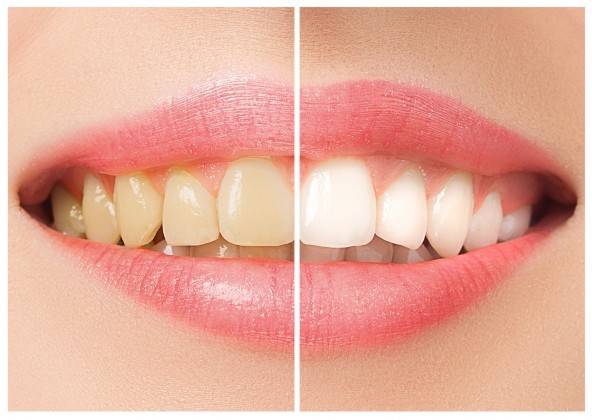Teeth Whitening: The Facts
What causes teeth discolouration?
Teeth are a bit like sponges – they absorb colour from food and drink through tiny pores. Anything you ingest with strong colouring will absorb into these pores. Coffee, cigarettes, dark berries, and wine are some of the major contributors to stained teeth. Overtime your teeth will inevitably change colour due to these stains. These stains will not disappear unless you actively attempt to remove them.
How did teeth whitening become a thing?
Practically speaking, the effect of teeth whitening was in fact discovered by accident. Dentists had been using mouth rinse containing hydrogen peroxide to treat gum disease. With those patients who frequently used the mouthwash they noticed teeth became increasingly whiter overtime.
Socially speaking, Teeth Whitening has become increasingly popular through celebrities/influencers and a person’s want and desire to improve their self confidence.
What’s the main ingredient in teeth whitening products?
Hydrogen peroxide is the active ingredient in most whitening products, some teeth-whitening gels contain carbamide peroxide or sodium perborate. Both of these agents break down to release hydrogen peroxide.
Does teeth whitening cause damage to my teeth?
Any abuse of your teeth, such as aggressive brushing, can be damaging. However, when used as instructed, professional teeth whitening is incredibly safe. Unlike crowns and veneers which usually requires a dentist to remove valuable tooth structure, teeth whitening is non-invasive and simply lightens and brightens tooth enamel.
Is teeth whitening expensive?
With the improvements in teeth whitening technologies, teeth whitening has become more affordable than ever. This has made it extremely popular as an easy way to give your look a makeover. This affordability is perhaps one of the greatest benefits of professional teeth whitening. While other beauty enhancing procedures can be extremely expensive, teeth whitening is a safe, cost-effective alternative for transforming the way you look. Teeth whitening kits and products include: whitening trays, strips, rinses, and toothpastes. Prices range from approximately $10 to $150 depending on the product. In-office teeth whitening services start around $500.
Ways of limiting your teeth discolouration without using teeth whitening services:
- Quit smoking and tobacco products
- Limit coffee, soft drinks, and wine
- Rinse mouth with water after snacks, meals or drinks
- Sip drinks through a straw
- Use whitening toothpaste
- Switch to an electric toothbrush (penetrates stains better)
- Floss regularly
- Keep plaque under control (stains latch onto plaque)
- Maintain regular twice a year dental cleanings
Types of teeth whitening: Home (over the counter) v Dentist (in-office)
Over-the-counter teeth whitening kits have become popular since they are inexpensive and easy to use. They contain lower amounts of peroxide than the whitening products used by dentists, but some people can have good results though it will take more time. If you are buying over the counter or DIY kits (including whitening trays, strips, rinses, and toothpastes), then make sure you choose products from reputable Australian or US suppliers. Don’t be tempted to save a few dollars buying unreliable products subject to poor hygiene and quality control. There’s also plenty of scam companies out there, so check the credentials of the company first.
Professional teeth whitening is the preferred method of whitening as it is stronger and more effective than over the counter whitening agents. Under Australian law and the Dental Board of Australia regulations, only dentists can use teeth whitening products containing more than 6% hydrogen peroxide (or 18% carbamide peroxide), but it is important to note that under Dental Board requirements, these stronger products can only be used for in-office whitening procedures.
At this higher concentration, hydrogen peroxide can effectively permeate deep into the enamel structure. Weaker concentrations act only at the surface of the tooth enamel. Lab-based research suggests in-office whitening by dentists increases the strength of enamel, making it more resistant to erosion from acid.
What is the procedure of teeth whitening in-office?
During an in-office teeth whitening visit, your dentist will apply whitening gel on the desired teeth, and a light is placed in position in front of the mouth for the first twenty-minute cycle. The gel is then removed, then reapplied, and the steps are repeated for another three cycles. However, those sensitive to light or taking light-sensitive medications should consult with their doctor before undergoing this procedure.
The light used to activate hydrogen peroxide solution – will it hurt me?
The UV or LED light used is just that – a light that won’t harm you at all. Beams of light are used to activate the products used to whiten your teeth in the office. By using a light sensitive product, you can get the same results in about an hour or two than it would take you several weeks to get using a custom tray. Precautionary measures are also taken to protect your face and eyes from the gel and the light.
How do I keep my teeth white after the treatment?
Your teeth will not remain this white forever, there are numerous things you can do though to help your situation though.
The first step to keep your youthful, white smile young and bright is to stay away from foods and drinks that are known for staining your teeth. Likewise, smoking will also reverse the procedure.
Your teeth whitening process can last a lot longer if you adopt proper dental care habits. Allowing superficial stains to sit on the surface of your teeth can make the stains more difficult to remove in the future – it is important to brush and floss regularly.
For a longer last or to enhance the result, you should also speak to your dentist about constructing a routine that works to preserve the look and lustre of your smile. Your dentist may send you home with a whitening system called DayWhite, which allows you to whiten your teeth at home.
